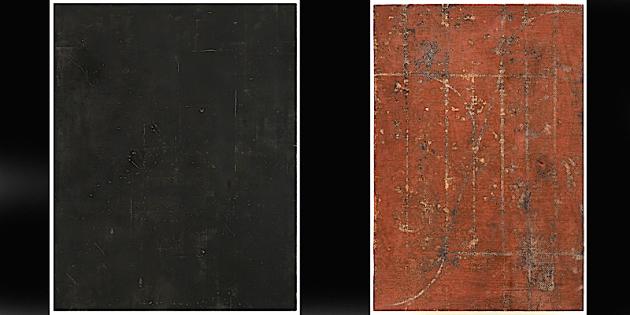Imagine if you will the ocean at night; the push and pull of the tide under a vast starlit sky, the hushing sigh of the waves that break at the murky shore where you walk barefoot in the sand. In front of the wholeness, the infinite entirety of the sea and the night, a man can feel very small again. Meaning has eluded our cosmic wanderings, and we end up lost upon the beach like the forsaken figure in Friedrich’s “Monk By The Sea” or the lone fisherman in Turner’s “Evening Star”.
Matteo Fuzzi offers us no easy answers in navigating the quandaries of such an existence. His large black paintings instead exert an elusive ambiguity, drawing the viewer in with the waning call of an immense dark void – as dense as the nocturnal ocean. Other smaller works set up their own beguiling enigmas through their almost impenetrable fields of scorched pigments and earthy colour. They are marked by lines that establish the sketchy parameters of esoteric shapes. These could be half-forgotten signs, the hesitant formation of a new alphabet scratched in the dust and left to fade into oblivion.
Further looking, however, reveals a continuous state of agitated movement enacted upon and beneath the painted surface. The title “Burnt Fields” relates directly to various elements engrained within the artist’s memory. The painting process is linked to experiences and feelings that are enacted upon a two-dimensional surface. The artist recalls the landscape inspired by his travels in Italy, which undergoes a remarkable transformation with the changing of the seasons. Fields are burnt to remove the stubble of the crop. This destructive act becomes almost sacrificial, a necessitated action to appease the unseen natural forces at play. The process leaves the soil with a thick patina that the artist so keenly evokes, a rich darkness like a black coat.
As in the burnt fields, there is more going on under the surface of Fuzzi’s paintings then is revealed at first glance. Just as the land continues to hold its regenerative potential, the artist’s work also suggests a potent transformative power. Fuzzi both redacts and discloses painterly information, leaving traces of his decisions behind as a snail leaves behind a glistening trail. Carefully, he pores over the surface of his work, slowly building up coats of thick pigment, layer upon layer, and then grinding them down again until the support (wood, canvas and paper) stops feeling redundantly material but becomes alive instead, charged with dynamic energy.
The artist’s process becomes an exploratory journey of an almost alchemical bent, revealing the cosmic nature of existence through the base dirt of our material reality. Language becomes inadequate when attempting to speak about paintings, words like marks scratched upon the dry surface of the page, purged of content and meaning. So much of the power of painting, we are reminded, lies within the act of looking, of allowing our mind to drift upon the ebb and flow of the imagination.
Matteo Fuzzi – Burnt Fields Words: George Eynaud (see exhibition details below)

